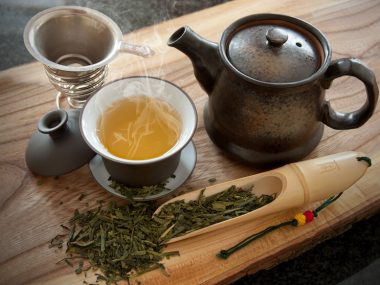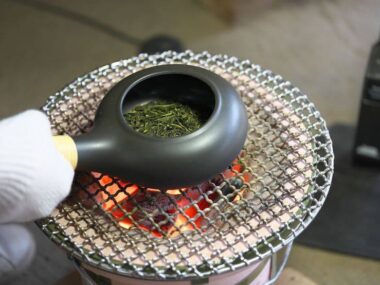Many online sites proclaim Ceylon tea is nothing more than a “type” or “brand” of tea. These assumptions are false, and we are about to tell you why.
Table of Contents
What Is Ceylon Tea?
“Ceylon” tea is a strictly regulated, licensed black, green, or white tea that is only cultivated, processed, and packaged in Sri Lanka. Ceylon is a quality classification rather than a brand.
We are about to open your eyes to a tea that is under the strictest regulations to qualify as Ceylon. “Ceylon” is a rampantly used marketing ploy to give tea consumers the impression they are getting a high-quality tea. However, it’s just the opposite because thousands of teas are being marketed as Ceylon when they’re not.
How To Recognize Authentic Ceylon Tea
Genuine Ceylon tea must bear a globally trademarked lion logo owned and controlled by the Sri Lanka Tea Board. By law, tea producers cannot market tea as “Ceylon” without going through an approval process with the tea board. If approved, the tea board grants a license to the tea producer to cultivate, package, market, and export their tea. There are strict standards that fall under the license.
- For tea to qualify as “Ceylon,” it must exceed the standards of ISO 3720: 2011 Black Tea.
- Tea packaging (except bulk tea) is to have the Ceylon lion logo imprinted on the tea packaging. No stickers are allowed to be used in lieu of an imprint.
- The logo symbolizes quality guaranteeing that the tea is 100% pure Ceylon produced and packaged in Sri Lanka.
- At any time, the tea board can evaluate a tea producer’s Ceylon tea and if the standards are not being met, the license is revoked.
The Ceylon lion logo is registered (trademarked) all over the world. The lion is displayed on the Sri Lanka flag and it was befitting that the Ceylon tea logo also displayed the lion.
So, if you happen to see a tea marketed as “Ceylon” yet it lacks the logo or the package has a sticker version of the logo, odds are it’s an imposter and not real Ceylon tea. The Sri Lanka Tea Board does not profit from tea producers. The logo is a brand but more of a quality control and guarantee that the tea is top-shelf.
The History Of Ceylon Tea
Sri Lanka was once known as Ceylon. A Scottish lad came to Ceylon with a vision to start a tea empire. James Taylor arrived in Ceylon in 1852 and began his tea cultivation endeavor by planting 19 acres of tea. This crop was produced from Assam tea plant seeds which Taylor acquired.
The tea plants were such a success that he became known as the father of the Ceylon tea industry. Through endless bouts of trial and error, he achieved and perfected the processing of the tea leaves. Ceylon tea swept across the world like wildfire, quickly gaining momentum as one of the finest teas on the market.
Ceylon’s name changed to Sri Lanka in 1972; however, that didn’t affect the sales of Ceylon tea for teas bearing the prestigious title and logo continue to be some of the world’s most desired teas.
Different Types Of Ceylon Tea
There are seven different regions in Sri Lanka that produce authentic Ceylon tea.
7 Tea Regions Of Sri Lanka: Elevations And General Tea Characteristics
Tea producers refer to Ceylon teas as one of the seven regions. Tea packaging may have an origin (or tea) labeled as one of any of the below. Each region produces distinctive tasting teas.
- Nuwara Eliya
- Highest Elevation: 6000+ feet
- Refined
- Uda Pussellawa
- Higher Elevation: 5,000 to 6,000 feet
- Tangy
- Dimbula
- High Elevation: 4,000 feet
- Smooth
- Uva
- Medium Elevation: 2,000 to 4,000 feet
- Exotic and aromatic
- Kandy
- Low Elevation: 2,000 feet
- Smooth
- Sabaragamuwa
- Low Elevation: 2,000 feet
- Smooth
- Ruhana
- Lowest Elevation: at sea level
- Unique
Ceylon Black Tea
Black Ceylon tea is almost always a pekoe (a grade classification.) Most of this tea is used to blend with other teas or used in making tea bags.
Grades Of Ceylon Black Teas
- Pekoe: buds processed into the sphere-like balls
- OP (Orange Pekoe): larger leaf with smooth/sweet flavor
- BOP (Broken Orange Pekoe): broken leaf
- BOP1 (Broken Orange Pekoe 1): semi leaf from low elevations that is malty with notes of caramel.
- FBOP (Flowery Broken Orange Pekoe): almost the same size as BOP but has a more coarse appearance with less tea leaf tip.
- FBOPF EX SP (Flowery Broken Orange Pekoe Fanning Extra Special): whole-leaf black tea with extended tips.
- FF1 (Flowery Fannings 1): tiny particles blended with medium leaves and tips
- BOPF (Broken Orange Pekoe Fannings): particles of black tea from higher elevations that are robust in flavor and used to make teabags.
- Dust: tiny particles of black tea that used to make teabags.
Ceylon Green Tea
Tea producers in Sri Lanka produce several different green teas under the “Ceylon” umbrella. They include Chun Mee, Gunpowder, Green Curl, Sowmee, Sencha, and a powder made from green tea fannings and dust. Some readers ask, “Is Ceylon and green tea the same thing?” Because “green tea” is a broad term for hundreds of green teas produced worldwide, it would suffice to say Ceylon and green tea are not the same thing. However, when referencing a green tea produced in Sri Lanka that bears the Ceylon lion logo, it would be correct to say Ceylon and those green teas are the same.
Ceylon White Tea
Tea estates in the higher elevations, such as Nuwara Eliya and Uda Pussellawa in Sri Lanka, produce Ceylon white tea that includes Silver Tips and Golden Tips. Both of these white teas are considered very rare.

What Does Ceylon Tea Taste Like?
Because Ceylon tea can be black, green (Gunpowder), or white (Silver Tips, Golden Tips,) the flavor will vary. Regardless of which type of tea you try, its taste will be pure, smooth, and, as they say in Sri Lanka, “refined.”
Each of the seven tea regions has a unique climate and terroir. One area may produce black tea that has an altogether different taste than one produced in another tea region. There’s a Ceylon tea to fit almost every tea drinker’s discerning preferences.
Ceylon Tea Caffeine
Black, green, and white teas can have as much as 40 mg of caffeine in a six-ounce cup. And if you’re wondering, “When should I drink Ceylon tea;” well, it’s best to enjoy Ceylon tea up until about 3:00 pm. Consuming a caffeinated tea anytime after that may cause difficulty in getting to sleep.
What Are The Health Benefits Of Ceylon Tea?
When it comes to the benefits of Ceylon tea, there are numerous ways tea drinkers benefit from enjoying this tea. Ceylon tea benefits are derived from constituents (such as phenols) that are naturally occuring in tea.
A published research manuscript in the Current Pharmaceutical Design Journal highlights findings on how tea boosts the immune system, helps to reduce the risk of heart disease, aids in weight loss, wards off viruses and infections, reduces dementia related diseases, and much more.
Can I Drink Ceylon Tea Every Day?
This question is difficult to answer because we don’t have the expertise to provide recommendations or advice when it comes to drinking any tea. If you happen to have any existing medical conditions, are taking medications, have a caffeine sensitivity, or are undergoing chemotherapy or radiation, tea may cause an interaction or adverse reaction.
We recommend talking to your care provider (if any of the above applies to you.)
How To Drink Ceylon Tea
Because Ceylon teas can be black, green, or white, we have included directions on how to enjoy them.
Ingredients
- 2 cups of water
- 2 teaspoons of loose-leaf Ceylon tea (black, green, or white)
- 1 teaspoon of honey (optional to sweeten as desired)
Directions
- Heat the water to the recommended temperature:
- Black 206 degrees (F) (97 degrees C)
- Green 180-185 degrees (F) (80-85 C)
- White 185-185 degrees (F) (79-85 degrees C)
- Remove from the heat.
- Place the loose-leaf tea into a tea infuser and drop it into a teapot.
- Cover and allow the tea to steep.
- Black 3-5 minutes)
- Green 1-3 minutes
- White 1-3 minutes
- Remove the tea infuser.
- Pour the tea into a teacup and enjoy!
Pairing Tip:
- Black Ceylon tea goes well with desserts such as pie, cake, and scones.
- Green Ceylon tea is perfect for enjoying with roast turkey or chicken, salad, or seafood entrees.
- White Ceylon tea is a lovely tea to have with tea biscuits.
An Unrivaled Pure Tea
Now you know why Ceylon tea is the best in quality. If you are diligent to source a Ceylon under all the above conditions we mentioned, that next cup of tea will be an experience you won’t forget.






